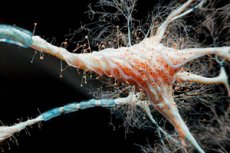
单个大脑神经细胞会激活免疫蛋白,将某些不愉快的事件固定在记忆中。
记忆的形成与神经细胞网络的转变息息相关。神经元之间的一些连接会增强,另一些连接会诞生,还有一些连接会消失。这些转变伴随着基因和分子结构的剧烈变化。科学家经常会发现参与记忆形成和信息保存的某个基因或蛋白质物质。然而,记忆支持的整个分子遗传机制对我们来说仍然是个谜。
在最近的研究中,科学家们描述了位于海马体的一组神经细胞。这些结构的作用机制变得相对清晰:特殊的DNA损伤后,它们会引发炎症过程。
爱因斯坦医学院的代表们对啮齿动物进行了一项实验:在特定条件下,对它们的爪子施加微弱的电击,以激活其记忆不愉快事件的功能。然后,如果将啮齿动物再次放入曾遭受电击的笼子中,它会惊恐地僵住,表现出应激反应。科学家发现,在应激暴露后,海马体中的某些神经细胞会形成炎症反应,这是由与TLR9(即Toll样受体)蛋白连接引起的。
这类受体属于先天免疫保护类型:它们对大型致病菌群的典型表现表现出反应。当威胁出现时,这些受体会启动细胞结构内的某些过程,并将出现的问题告知邻近细胞和免疫系统。
在普通的海马神经细胞中,记忆基因在DNA损伤后会迅速被激活。TLR9蛋白是确保必要信息存储在记忆中所必需的:当这种蛋白被关闭时,啮齿动物无法长时间记住不愉快的情景——尤其是它们在接触电流时所经历的压力。
TLR9 是如何启动的?DNA 出现在神经细胞的细胞质中,并被置于特殊的膜泡中。激活的 TLR9 启动了 DNA 修复过程:与此同时,一系列调节蛋白出现,DNA 颗粒聚集在细胞器——着丝粒上。因此,指示基因组损伤的 DNA 颗粒与 TLR9 和其他蛋白质物质一起,在细胞核中启动了 DNA 修复。整个过程只有一个目标——形成长期记忆。
尽管TLR9是一种与炎症反应相关的免疫蛋白,但实际上并不存在真正意义上的炎症过程:神经细胞仍然正常运作并存在。它所利用的只是两种相似的免疫机制和神经记忆,它们拥有相同的分子工具。在某些阶段很可能仍然存在差异。然而,科学家们必须在后续研究中进一步研究这些问题。
《自然》杂志页面详情

